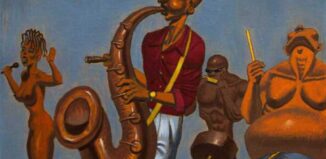TITO’S DESCENT
By Marylee MacDonald
If you lose a friend in his youth, the years after such a loss become a kind of afterlife, an unreality, as if you, yourself, are fixed in that time when death lies far in the future. At first, you miss them, and all the questions of whether there is a heaven immediately stand in your path. The person you love like a brother is gone, shimmering in the stream of memory, and that is the picture you carry forward, taking it out now and then and pondering how the miraculous and the tragic can coexist.
Back in April 1968 when Tito led us down into the cavern, we had no fear of death nor suspicion that what we were about to find would splash our names across the Spanish newspapers, and indeed, the newspapers of the world. With the promise of a few pesetas, two local boys — mascots, of sorts — agreed to guide us. The boys said that our destination, the Well of Ramu, had no bottom, that their grandmothers claimed evil spirits lived inside the bluff. Shepherds, standing on its top and looking out toward the Atlantic, had many a time been startled by the eerie-sounding moans of disembodied suffering. The moans came from a pothole called the Well of Ramu, but, perhaps I should explain for the benefit of those urban dwellers who will watch your documentary that this “pothole” was not the kind of pothole one finds in cities, where the asphalt washes away and a street crew must be summoned to throw in a couple of shovelfuls of macadam. This was a geological pothole, a hole in the tabletop of a bluff into which a stray sheep or goat might fall to its death.
Neither Jesús nor Aurelio believed the tales, but they thought it well to warn us. They wanted to show us a different cave. Some crawling, but big grottoes and excellent formations. Most certainly worth the effort and “much easier for the girls,” Jesús said from beneath the first traces of a mustache.
“Don’t worry about the girls,” Tito said, championing the three of us. “We go all together, or not at all.”
Tito sprang over the stone fence that encircled the pothole and dropped to his knees. “The main thing is to determine how much rope we need.”
Then, flattening himself on the ground and with a handful of rocks, he slid his shoulders over the abyss.
Potholes were new to our caving group. In fact, I had never heard of a pothole until Tito proposed this expedition. The guides were country boys and had never rappelled down into one either. Aurelio, the older of the two, warned us not to get too close to the edge in case our weight made the ground collapse; but curiosity got the better of them, and they, too, flattened themselves around the perimeter, cocking their ears and listening to see how long it took for Tito’s stones to hit bottom.
Your cameraman asks why we spelunkers didn’t lower a lantern. A lantern only works if the floor of the cave is near the surface. Otherwise, darkness swallows the light. We could only determine the depth by feel, so when Tito couldn’t hear the stones strike bottom, he lowered a lead fishing weight, the hefty kind fishermen in Ribadesella once used to sink their nets in the ocean. I suppose they must still use them, come to think of it. As to where he’d found one, I don’t recall precisely, but Tito was very careful about bringing whatever we might need for the caves he wanted to explore, and I think he had borrowed the weight from a cousin. By the time we were finished with our preparations, we had five climbing ropes of eighty meters each tied together.
The plan, Tito said, gathering us around, was for him to descend first, assess the situation, and then send down one of the guides.
Instead of saying “of course,” the guides looked at one another.
Aurelio, maybe fourteen, said that when the boys explored caves, they slithered along with flashlights until the batteries dimmed, at which point they backed out.
“Do you want to go down or not?” Tito said.
“I’m scared,” Jesús, about thirteen, said, “but, yes. I’ll try.”
“One of you must stay behind.”
“Can’t we both go?” Aurelio said.
“It’s better to draw straws,” Tito said. “If we get injured down there, the one up here can run for help.”
“Where should we go?” Aurelio said.
“The mayor’s house,” Tito said, nodding his head in the direction of the town across the river. “Or the Guardia Civil. And, if the one who draws the longest straw is still scared to jump into a dark hole, one of the women can show you how it’s done.”
The boys smirked at us girls.
The younger, Jesús, drew the short straw. “So, am I just supposed to wait here, or what?”
“Yes, wait,” Tito said. “Once we’re down, you’re the only way we can communicate with the outside world.”
Tito secured the rope around a boulder and attached carabiners to his climbing harness. Saluting, he slid over the lip.
Adolfo, a bull whose callused hands came from years of scything his father’s hay, stood over the coil, the rope running around his leather-vested back and through his hands. Counterbalancing Tito’s weight, he lowered our leader down.
There were twelve of us in the Torreblanca Speleological Society, mainly geology students at the university in Oviedo, plus Tito’s sister and one of her friends. The name “Torreblanca” came from the town where Tito grew up. I know “Speleological Society” makes it sound like we were some kind of learned group, sitting around and drinking port and discussing academic articles about rock strata, but we weren’t a “society” at all. Our youngest was fifteen and the oldest twenty-two. Eight were geology students — always out in the field, gathering rocks and carrying them back to the lab to hammer apart and examine. Tito, though still not finished with his baccalaureate, had already discovered his life’s passion. Tito was a real rock-hound, completely mad for rocks.
In order to join the Torreblanca Speleological Society, as founder and self-appointed president, Tito insisted that we each buy the basics: a helmet, carbon lamp, and Levi’s from the store where workmen bought their clothes. For caving, he preferred rubber waders, but he let two of us get away with hiking boots — what he wore when he went out with his mountaineering friends. His kit of chocks, carabiners, and climbing ropes filled the trunk of his car.
These days, when I think of Tito, I see him in that famous photograph: in his helmet and muddy, as we all were. Chin down, he is spooning cold beans from a can. We are all smiling and looking at him in wonder. His appetite had become a joke. Bony shoulders with a hunch that hinted at his shyness, all elbows and skinny legs, Tito was a study in angularity. A shock of hair hung over his forehead, and the camera caught him looking down into the can. If I have one regret, it is that Fernando, our unofficial Society photographer, having lined us up, did not say, “Tito, amigo, look at the camera.” I should so have liked to see the tiny windows of light in Tito’s coal-black eyes.
We later learned that the Well of Ramu was actually four hundred meters deep, the length of four football fields, and because of its depth, the temperature remained a constant ten degrees Celsius, barely above freezing. The caves we had explored before this were not quite as cold and often high up, generally an opening on the face of a cliff. To reach them we had to climb, and afterwards, rappel down the rock face. To do that, we slid the rope under our behinds and then leaned back, letting the rope play out as we backed down or bounced down the vertical wall. In the case of the Well of Ramu, we had no wall with which to brace our feet and slow our descent. Our hands served as our only brakes, and when we dropped into the pothole, the rope slid through our gloveless hands.
I was supposed to show Aurelio how to manage the rope, but as I lowered myself down, I found that even twining my legs around it did not slow my descent. By the time I reached bottom, my hands burned, and blisters were already forming. I pressed my palms together, wishing the pain would stop, and took a step back from the rope, my waders sinking in. Mud over-topped them.
“Watch out!” I cried. “Quicksand!”
Tito had been standing nearby and grabbed my arm. “I think we’ve landed in a riverbed.”
“It’s the San Miguel,” said Aurelio, letting go of the rope and dropping freely the last three meters.
And, indeed, the sound of water echoed through the chamber, a gurgle that made me think we might step into the channel and be washed downstream. The things I feared most in caves were being sucked by the force of a river that would be too powerful to resist or stepping out into space and dropping into a lower chamber. My armpits began to tingle and, despite the cold, sweat formed on my upper lip.
Partly to overcome this aversion to confined spaces and partly because of Tito himself, I had joined his club, and now that he had accepted me, I dared not confess that in narrow passages, where I had neither room to turn around nor squirm and where I could see only the boots of the person crawling ahead, I feared the rock would shift and crush me.
The two other girls followed next, and then studious Fernando, who had a crush on Tito’s sister, but was too shy to ask her out. Adolfo, whom Tito called “the human crane,” came next, and finally little Ruperto, the youngest member, age fifteen. A lighter snapped briefly, illuminating his profile, and a moment later, I made out the glowing tip of his cigarette. Trying to appear older, no doubt.
We had all made it down safely.
“Let’s see where we are,” Tito said. “Each of you turn a hundred and eighty degrees and take five steps.”
We did and, in the faint illumination of our carbide lamps, saw that the mud, the murky grayish-brown of a tidal flat, extended beyond the reach of our beams. The cave smelled like no other cave we’d been in before, the air dank and humid, like an ice box exploding with rotting cheese and moldy bread. The river, hidden from view, sounded close, but to reach it and possibly follow it to where it emerged from the earth, we would have to cross the reeking, gray pudding of mud.
The pothole, through which we had descended, and the rope, our only way out, stood behind us, and I was tempted to turn around and keep a hand on it. Were it not for the light falling from above, I could not have told up from down. It was discombobulating.
“Now take five more steps,” Tito said, as if we were playing “Mother, May I?”
When the group had spread out so that each person, leaving his companions, felt a chilling awareness of the cold, Tito said to stand completely still and tilt back our heads.
I did.
Looking up, I could not see the top of the cavern, only a barricade of stalactites as evenly spaced as the twisted, iron bars on a window.
“Which way, do you think?” Tito asked the guide.
“To the right,” Aurelio said, sounding assured for his age.
“To the right it is,” Tito said.
And, then, as if needing to justify himself further, the guide said, “The air is cooler in that direction, and the sound of the river louder. This way should take us to the cave I told you of.”
“And?” Tito said.
“From there we should be able to walk out.”
“But you don’t know that for certain?”
“I don’t know if the passage is open,” Aurelio said.
“Let’s take a quick look,” Tito said.
“What about us?” I asked on behalf of the female contingent.
“All for one, and one for all.” Tito waved his hand inclusively, beckoning us to follow.
His and Aurelio’s lamps bobbed toward the gurgle, less river than burbling creek, its sound magnified by the echo chamber of the cave. A drop of water landed on my cheek, but when I looked up, I still could see no more than I would have seen in my grandmother’s windowless root cellar.
Walking away from the rope plunged me into darkness. As I rocked forward, mud sucked the wader from my heel. I tested each step and waited for the ground to render itself firm. The others cried out and cursed the sucking mud. It was impossible to move quickly, and I was breathing hard by the time I could see that rocks and boulders blocked our way. I placed my hand on one of the rocks for balance. I stopped. Had the stone dislodged from the ceiling, or had the river carried it in? Maybe Tito could tell. Meanwhile, the hiss of carbide, snaking up the tube on my back, reminded me of the hissing, slithering, eyeless albino salamanders we had seen in another cave. I hoped we wouldn’t come upon any creatures like that in this airless space.
Tito told us to wait while they explored, and if this didn’t prove to be a passageway, we could search the cavern for another. So far I hadn’t felt the air movement Aurelio claimed would lead us to the other cave, and I began to think it would be better for us to stay in this large chamber where, at least, we could look back and see the shaft of light beaming down from the pothole.
Tito squeezed sideways through pointed, egg-shaped rocks as gigantic as those the Arabic astronomer Ibn Yunus was said to have used as gnomons. Meanwhile, Aurelio ducked into a fissure that looked as though it led to another cavern, and I thought he might find another big room, but without the river running through it. Shivering and hugging ourselves, we heard his boots splash through water and Tito cautioning Aurelio to watch his footing. When they found themselves in the same passageway, Tito called back and said they could stand upright, but not see daylight. That meant the walk out could take a long time.
At last, their lamps bobbed back in our direction.
They had been gone half an hour, and I had no confidence that we could get out this way. What if we encountered more blockages? It might be better to follow the river in the other direction. I turned toward the sound of water. Above me, I saw a flash of red. It startled me.
“What’s that?” I asked.
“What’s what?” Tito said.
“Red.”
“Where?”
Looking up and trying to relocate the color on an overhanging rock, I moved sideways from the boulder. Because I had taken my attention momentarily from the ground, my feet slipped, and I fell, scraping my blistered hands and letting out a yell.
Then Tito had me by the elbow. His lamp blinded me, and my heart thrummed in my ears. Unlike the others, I was an art student, and the vividness of that red could only mean one thing: paint. I squinted, looking in vain as my headlamp’s faint beam moved across the undulating rock above my head.
And then I saw it: the charcoal silhouette. A single horse’s head. The horse had ears, nostrils, and the same throat latch—that thickening on the bottom of its muzzle—as horses in the pastures of Ribadesella. What was different was its mane. The mane stood as stiff and upright as a zebra’s.
“Look up there.” I pointed.
“A horse,” Tito whispered in awe. He put his arm around me and drew me closer. He was trembling.
I had never been as aware of my body as I was at that moment. The warmth of another human being, the sideways pressure of his hip, the squeeze of his fingers against my arm, the ripple of sensation from my forehead to my feet, made me feel as if we humans were designed, on a primitive level, to connect with one another not just with words, but with the intimacy of touch; that touch was essential for our well-being and the reason we have bodies, not just souls.
The others joined us, and Tito released me. Once again our leader, he directed us to form a line and tilt our heads in unison. Tito’s sister, Eloisa, squeezed between us and put her arm around me.
Hefty little Pilar, one of the most irreverent women I’ve ever met, had her arm around my hip. “What gives?”
“Cave paintings,” I said.
“Like at Altamira?”
“Well, we’re not far from there.”
Our lamps illuminated a swath of red.
“Is that blood?” Pilar asked.
“No. Ocher or iron oxide.”
Honestly, at the time, I had no idea what kind of pigment paleolithic artists might have used. I only knew that blood would have darkened and chipped away.
The artist had applied an orange-red wash to the cave wall just below the horse’s head. In the illumination of our combined head lamps, a herd of horses jumped from the darkness. Six that we could see immediately, although with better light, the archaeologists would later document more. The herd faced the opposite direction and appeared to move across a plain of red that might have been grasslands set afire.
Of these figures, the best preserved was a mare in the fullness of pregnancy. Horizontal bands of black and white circled her legs, reminding me of the mimes who perform in traveling circuses. It gave her a comical aspect that drew a smile.
Most remarkably, the artist had painted her body violet. Could it be that horses in prehistory were violet? In every other respect the horse was as realistic as if Goya himself had drawn it.
We lingered, tracing the animals with our fingers and seeing if others agreed that, yes, that was a horse. Or perhaps a deer, for as we continued to examine the figures, we saw that some had antlers.
Our watches told us that the day had advanced past one o’clock, and though we had filled our metal canisters with carbide pellets, we had a maximum of four total hours before the fuel ran out.
We walked as a group around the cavern, unable to locate any other painted surface.
The Torreblanca Speleological Society was not a democracy, but Tito asked our preference. Should he attempt to monkey-climb the four-hundred-meters of rope and prepare to pull us out, or should we follow the river, in which case, we should get going or have Jesús send down more carbide just in case. Like coal miners, cavers have always used carbide lamps because the lamps can be refilled and the fuel costs next to nothing. With the river below, we would have water, and could add it to the canisters when the gas pellets fizzled out. The main thing was not to get stuck down here in the dark.
The group split evenly, six to six. We gathered around the rope and Tito called up to Jesús. Expecting to see his face looking down, I was stunned when he did not answer.
Tito turned abruptly toward Aurelio. “Did your friend run off?”
Aurelio nervously cupped his hands around his mouth and shouted.
Still no Jesús.
“Maybe he got bored,” Aurelio said.
If the passage proved to be a dead end, we’d have to come back here and wait for rescue. The ground was too muddy to sit.
“We need more carbide,” I said.
“I’ll get some.” Tito extinguished his lamp and took off his helmet. “Back in a second.”
Hand over hand, he ascended the rope, twisting it between his muddy galoshes. When he made it to the first knot, he rested and looked down.
“You can do it!” we shouted in unison. His face took on a look of determination. At the second knot he rested again, this time, calling up angrily, “Jesús, you lazy lout! Come over here.”
Jesús did not appear.
Halfway up the third section of rope, Tito began to slide. He tried to slow his descent at the second knot by clamping it between his insteps. That helped, but unlike when I had abseiled in, with the rope acting as a swing beneath my butt, Tito had no such control and landed beside us with a thud.
Determined to try again, he prepared to remove his galoshes.
“Let me try,” Aurelio said.
He did not even make it past the first section. By now, mud had made the rope too slippery to hold.
Tito put his helmet back on, and Ruperto took out his lighter and lit another cigarette.
“So, it’s to be the river. Aurelio, what is your opinion?” Tito said. “Should we follow it downstream or up?”
“My instinct tells me up.”
“Mine, too,” Tito said. “Back to the passageway.”
The prospect of discovering more paintings made us avid to stay underground, but not having the use of the rope made escape a necessity. Before we tore ourselves away from these paintings and began our trek to the exit, Aurelio ducked back into the fissure he’d explored. There he found a small chamber with deer incised on rock. Not painted deer. These were petroglyphs and finding them made him glad to have won the coin toss. Now, he could legitimately say he was the discoverer of the cave, or at least part of it.
Expecting more discoveries, we picked our way along the rock-strewn passage, our feet slipping on the slimy stones and me fearing that we would reach a dead end or an underground channel that would force one of us to submerge and try to swim against the current.
“Tito,” I called out, my voice swallowed in the dark. “What if our lamps go out?”
“I have some extra carbide,” he said, “and a dozen candles, but I suggest we not think of that and sing to keep up our spirits.”
“What shall we sing?” Maria Pia called.
“How about ‘Puppet on a String?’” Tito suggested.
Adolfo and Fernando began whistling, and the melody carried us along; however, we were concentrating so hard on where to put our feet that the lyrics simply drifted away.
After three kilometers underground, we caught the scent of fresh air. Just as the first sign of daylight appeared, our lamps sputtered out.
Ordinarily, when a cave is discovered, it’s a shepherd who stumbles in, usually unappreciative, which is why so few caves are recorded or mapped. But the Well of Ramu was different. No one knew it was there. We were the first.
Since then the cave has changed. Despite the three air locks, the artificial tunnel introduces outside air, and the unforgettable smell is gone. No one can experience it as we did fifty years ago.
It annoys me that I must pay an admission fee to bring my grandchildren, and it annoys me when people complain about the path being uneven and rocky and dimly lit. It is a cave. What did they expect? The last time I went there, a French-speaking woman was complaining to the guide, who happened to be Aurelio’s son, that she’d had to walk a long way back just to see a few paintings. She had expected more for her money.
When I heard this, I felt a tremendous sense of abandonment and loss. “You have been privileged to see one of the treasures of the world,” I said, “and yet you disparage it. This is not the same experience as going to the cinema.”
I wanted to tell her what a miracle it was to stand before those paintings for the first time, to wonder at the artists who painted them and held them sacred. To imagine the horses that must have been running wild. And I wanted to tell her about Tito, how vibrant and alive he had been as we probed these secret grottoes. How he dove into his can of cold beans right after we had made it back to the top of the bluff and startled Jesús, taking a siesta. How euphoric we were as we tore off our muddy clothes and had Aurelio direct us to the mayor’s house.
Would you mind turning off the camera? Good. Now I will answer your question. Do I think Tito was a risk taker? Certainly, no more than any other young man his age, an age that predisposes the male of the species to believe he will live forever. Tito had his full share of the invincibility hormone. It surged through his veins, and it was what drew us to him. Tito was brave. A leader. He believed in living life to the fullest, squeezing every drop of joy possible from his time on earth. And, remember, this was 1968, seven years before Franco’s death. In a certain way, to live boldly was an act of political defiance.
When Tito slipped in a mountaineering accident a few days later, his sister brought us the news. The Faculty in Oviedo called for a day of mourning. The train to Torreblanca filled with students, but we, who knew him best, drove. At the Mass, his father wept like a man who’d lost a part of his very soul. And because of Señor Bustillo’s intense grief, the authorities decided to name the cave in Tito’s honor. No longer the Well of Ramu, today it is the Cave of Tito Bustillo.
Just this morning, I was thinking about Tito, how he stood next to me in that cave and how my body rippled with pleasure. Tito and I might have had a future. Instead, what he gave me was a single moment of ecstasy. Following his example, I have sought to live every moment as if it were my last.
BIO

Marylee MacDonald is a former carpenter with a Master’s in Creative Writing. She’s the author of MONTPELIER TOMORROW, BONDS OF LOVE AND BLOOD, and THE RUG BAZAAR. Her forthcoming story collection, BODY LANGUAGE, is about people consumed by their infatuations, hungers, and fears. When she’s not at her desk, you can find her strolling in a redwood forest, hiking in the red rocks of Sedona, or exploring California’s Mendocino coast.


















